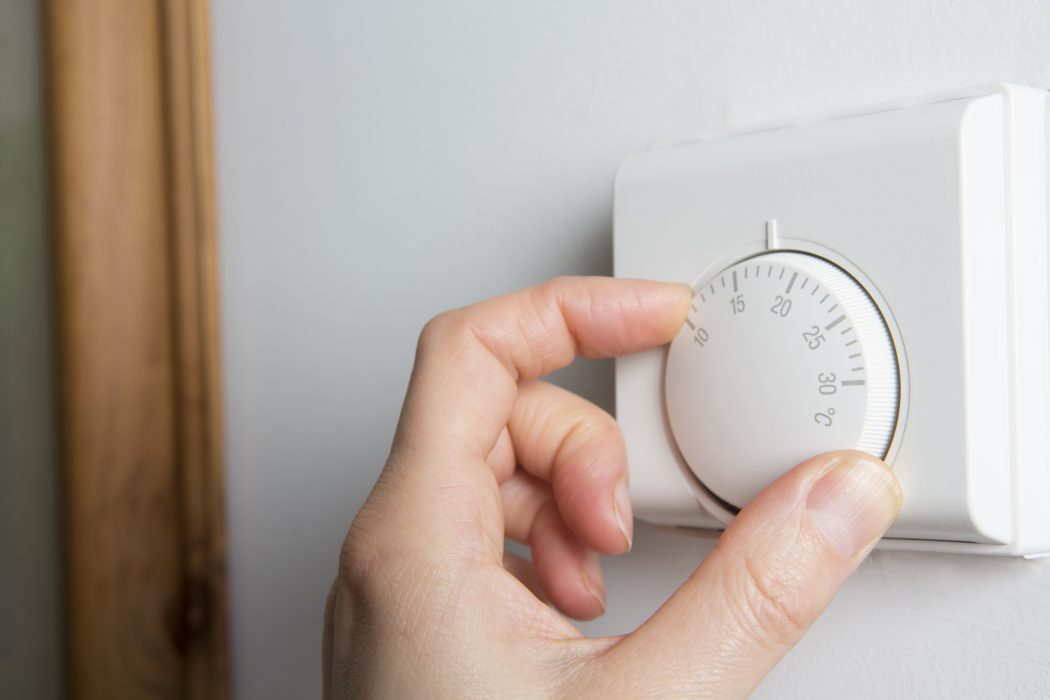The weather outside is frightful and cranking the heat is so delightful; however, if you want to conserve energy this winter, you’re going to need to make a few adjustments around the house. Winterizing can seem time consuming, but in the end, the best way to save money is to make sure everything is sealed up nice and tight. And when it comes to being energy-efficient, there are many ways to conserve that don’t involve your doors and windows. Take a look at the list below and stay warm this winter!
Adjust your thermostat
When the temperature drops below zero, most people can’t help but crank the heat. Nobody wants to come home to a cold house after a blistery walk, but that doesn’t mean you need to turn up your thermostat.
The best way to save on heating costs is to keep your thermostat adjusted to room temperature. If your nose is still cold, consider buying a space heater for the room you spend the most time in. That way, the rest of the house might have a slight chill, but you’ll be warm and toasty.
Use LED lights
The winter months are also the darkest months, which means you’ll need to turn the lights on much earlier in the day. To avoid sitting in the dark, switch out your regular light bulbs for the LED version. LED lights are not only energy-efficient, but long lasting; you won’t have to replace them as often and will save money in the meantime.
Make sure your holiday lights are also LEDs. Many people forget about the added costs of tree lights and house decorations, so be sure to check the box before you make your purchase. Consider using a timer for your holiday lights to ensure you never forget to turn them off before bed.
Unplug
With so many gadgets around the house, such as cell phones, TVs, and laptops, it can seem like every outlet is full of cords. However, many of our electronics and chargers use energy even when they are turned off. Unplug anything you aren’t using and only plug it back in when you need it. To simplify the process, try plugging everything into a power bar so all you need to do to shut down is turn it off.
Shop energy-efficient
When you are shopping, make sure everything that uses power is energy-efficient. Check labels and tags to see which is the most efficient and make informed purchases. This is especially important for your big appliances, such as the washer, dryer, dishwasher, and refrigerator, which tend to use the most energy.
Eliminate drafts
This is a big one. It means going around the entire house and checking to see where cold air is sneaking inside. There are electronic thermal leak detectors, but you’ll also find walking around in bare feet a good way to find those cold spots. Windows and doors are the most likely culprits, but be sure to also check anywhere connected to the outside, including your basement, attic, and exterior walls.
When it comes to windows, the seal is tightest when they are locked, so be sure to close everything properly. If cold air is still coming in, try using transparent film to help seal out the draft. Check to see if any daylight is coming in underneath your doors because you might need new weather-stripping.
Other major causes for cold drafts include exterior pipes and drains, outlets, and chimneys. Make sure everything is sealed and add caulking where necessary. Also be sure to check your attic, just in case you need to update your insulation or add a seal to the attic door.
Use the daylight
Although it might not seem like the sun is creating heat in the middle of winter, it is still able to warm the house up a few degrees during the day. Make sure to open your blinds and curtains when the sun comes up to let in as much daylight as possible.
After the sun goes down, close the curtains to keep the warmth inside. Invest in some thick curtains to help insulate the windows, especially for windows that don’t receive any direct sunlight.
Dress for the season
You’re going to need to lower the thermostat to be energy-efficient (see #1), so make sure you are dressed appropriately. Keep warm sweaters handy, throw on some thermal socks, and snuggle up under a warm blanket. It is surprising how much warmer you will feel just by wearing some slippers. Keeping your feet warm goes a long way during the winter months.
Clean your furnace
A regularly cleaned and serviced furnace is not only more energy-efficient, but will also help slow down the accumulation of dust. Check the filter in your furnace once a month and replace it whenever it is dirty. Unclogged furnaces have better air circulation capabilities and don’t have to work as hard. Also make sure all your vents and heating registers are cleaned regularly and are free from obstructions.
Upgrade your fireplace
Many old fireplaces sit unused in the winter months because they don’t seal properly, which is unfortunately because a wood-burning fireplace is a great way to add heat to your home. To fix the problem and enjoy the soothing crackle of logs in the fire again you’ll need an airtight door and chimney-top damper.
Having an airtight fireplace door is extremely important to be sure warm air isn’t escaping when the fireplace is in use, and cold air isn’t coming in when the fireplace is idle. Adjustable vents are also useful, just be sure they are only opened when the fire is burning.
Use less hot water
It can be hard to turn the hot water off and get out of the shower when you are finally feeling nice and warm, but one of the best ways to preserve energy at home is to use less hot water. That means you’ll need to keep your showers short, and only fill the tub halfway for baths. Be sure to install a low-flow shower-head if you don’t already have one, insulate your water heater, and set your water tank’s thermostat to a lower temperature if possible.
When it comes to dishes and laundry, you can also save energy by making a few slight adjustments. Whenever possible, use the cold cycle when washing clothes, and avoid washing many dishes by hand. Dishwashers are generally more energy-efficient than hand washing, as long as they are only being used for full loads. Finally, instead of using the heated dry setting on your dishwasher, just open the door and let the dishes air-dry.
Also on RNR:

























